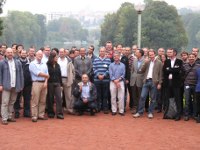 |
 |
|||||||||||||
|
|||||||||||||
|
|||||||||||||
|
Just after the ILC concept detector validation report was released, the CALICE (Calorimeter for the linear collider experiment) Collaboration met from 16 to 18 September in Lyon, France. This meeting was the place of lively discussions on the most recent test beam results and strategies for the R&D and studies for the future as the collaboration is entering now a crucial and intense new phase. It was the most attended CALICE meeting ever and nearly all participating countries were represented.
The meeting reached the record attendance of 91 participants. First reason is probably that France has a long experience in calorimetry and was one of the first countries involved in CALICE. There were also many newcomers from CERN joining the meeting. The new group called LCD – for Linear Collider Physics & Detectors Study – joined the CALICE collaboration last May. “It's a great sign for our collaboration that so many peopled attended this meeting just after the IDAG (International Detector Advisory Group) evaluation result,” says Felix Sefkow, spokesman of the CALICE collaboration. “This demonstrates that the strategy of building horizontal collaborations for detector R&D was good approach for developing ILC detectors and continues to be so.” François Richard, regional contact of the ILC research directorate discussed this IDAG validation result with the attendees . “We will need to intensify the contacts between detector concepts teams and R&D teams in the future,” said Sefkow. “We must show that we are aligned while we keep our options open.” Two new sessions appeared in this CALICE meeting. The first one was related to the arrival of CERN members. The "high-energy" topic is their main contribution. It includes the calorimeter studies for the range of CLIC's high energy. This work builds upon what has already been pursued within CALICE. (Read more about the ILC-CLIC detector developments). “It is pleasant to see how CLIC's calorimeter programme is well embedded and integrated into CALICE's. Our collaboration is very efficient this way,” said Sefkow. The second new session was about mechanics. These researches used to be mainly pursued by the detector concepts group. But now CALICE is entering a new phase, where they will need to evaluate the mechanical precision and challenges to work towards a totally integrated detector. During phase one, the data taking chain was validated together with the 'particle flow algorithm,' key to reconstruct a three-dimensional image of particle showers. Now that the CALICE collaboration has validated the proof of principle of their high-granularity calorimeters, phase two is crucial to make sure these detectors can one day be built for the ILC. It consists of the technological demonstration of the detectors where full-scale prototypes of at least each kind of calorimeters will be built. In order to design a truly realistic detector, CALICE needs to consider mechanical integration, complementing the work of the concept groups and showing that they are able to minimise dead zones in the detector and keep the mass as dense as possible. Test beams, especially combined ones, will be key to demonstrate that the complex integration of sub-detector layers and embedded electronics actually works. “IDAG acknowledged in its report the importance of the calorimeter test beam programme, and it was of course very encouraging for us,” says Sefkow. They are now able to understand and exploit nearly all the data which were taken from 2006 to 2007. During the meeting, they also discussed the results of the combined scintillator-electromagnetic (ECAL) and hadronic (HCAL) calorimeter test beam, which took place at Fermilab this year (see this NewsLine story). The proof-of-principle phase will continue in 2010 at Fermilab with the evaluation of gaseous read-out technologies for the hadron calorimeter, following the first tests of smaller set-ups which were also reported at Lyon. The new 'phase-two' integrated systems need test beam validation as well. This has actually started in parallel and encouraging tests of different gaseous HCAL detector elements at CERN were presented. Concerning the HCAL, one of the challenges of the detector is to reconstruct hadrons. The behaviour of hadronic particle showers is not yet very well modelled and the meeting was the occasion of constructive exchanges between hadronic calorimeters experts and GEANT4 – a particle physics simulation program – experts from CERN. The next CALICE meeting will take place in Texas, US, in spring. -- Perrine Royole-Degieux
|
|||||||||||||
| © International Linear Collider |

